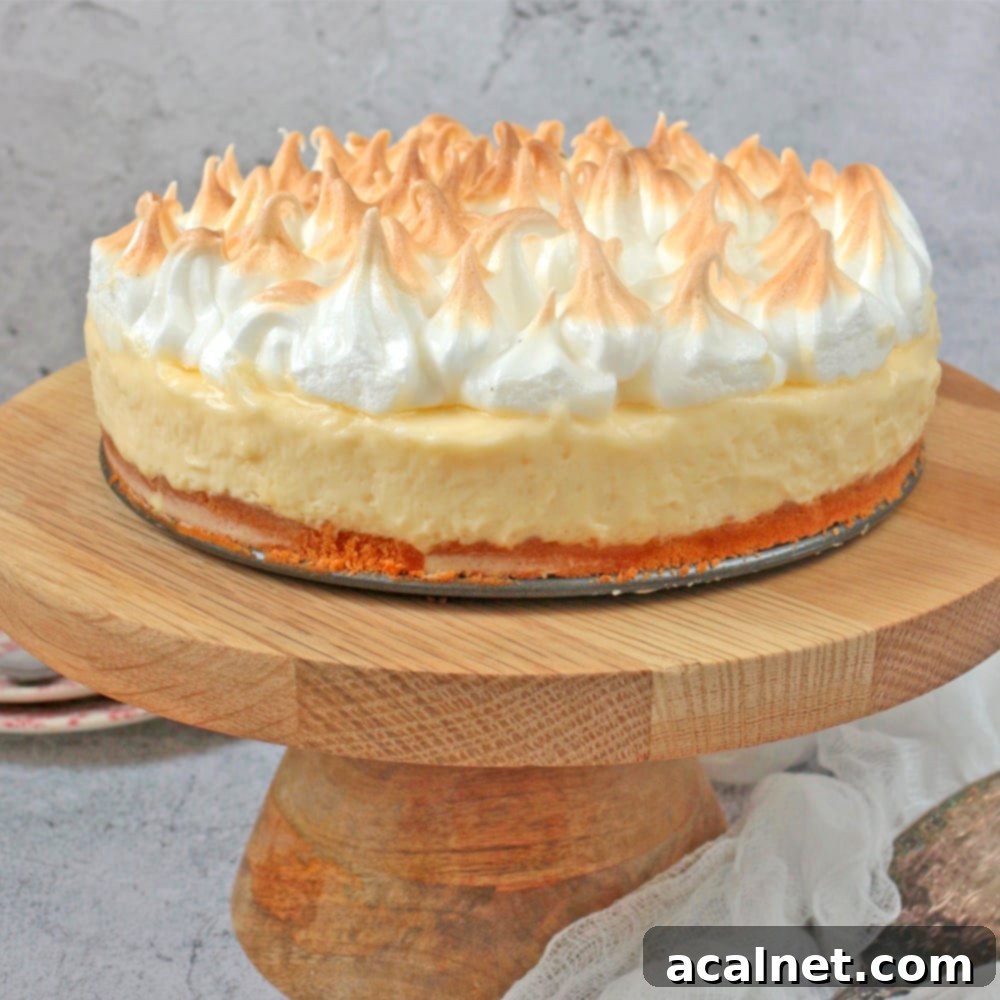The Ultimate Lemon Meringue Mousse Cake: A Zesty Celebration Dessert
Prepare to enchant your taste buds and impress your guests with this spectacular Lemon Meringue Mousse Cake. This isn’t just any dessert; it’s a sublime reinterpretation of the classic lemon meringue pie, transformed into an elegant, light, and irresistibly tangy celebration cake. Perfect for birthdays, holidays, or any special gathering, this unique creation promises to be a real crowd-pleaser, leaving everyone craving another slice of its delightful layers.
Forget everything you thought you knew about traditional lemon desserts. Our Lemon Meringue Mousse Cake takes the familiar bright, zesty flavors of lemon and marries them with the airy luxury of mousse and the sweet, cloud-like texture of toasted meringue. Each bite offers a harmonious blend of textures and tastes: a buttery, crumbly crust, a silky smooth and tangy lemon mousse, and a perfectly toasted, delicate meringue topping. It’s a dessert that not only looks stunning but delivers an unforgettable culinary experience.
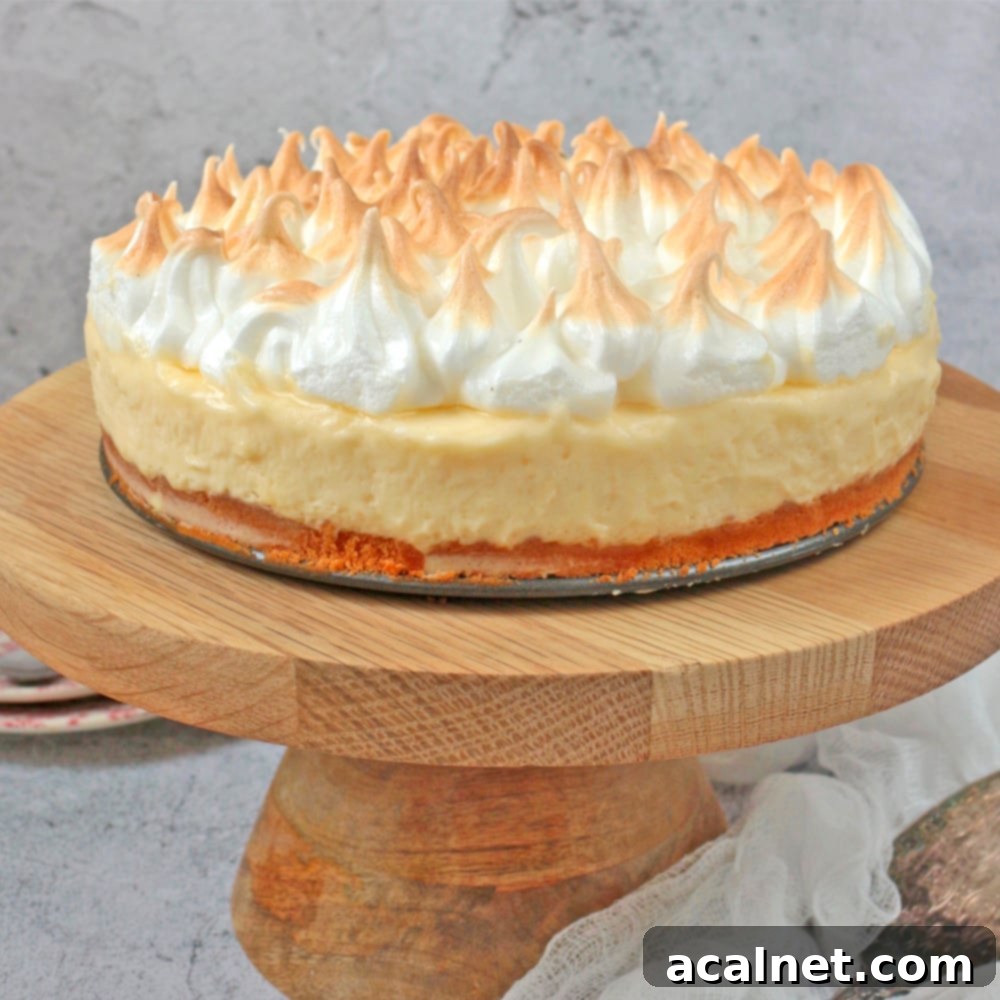
[feast_advanced_jump_to]
This exquisite Lemon Meringue Mousse Cake is a masterpiece built upon three distinct yet perfectly complementary elements, each playing a crucial role in its irresistible charm:
- A foundational Sablé Breton crust, offering a delightful buttery crunch.
- A smooth and vibrant Lemon Mousse, specifically a Lemon Bavarian Cream, that provides the cake’s signature tang and creamy texture.
- A billowy and beautifully Toasted Meringue topping, adding a sweet, airy finish and a stunning visual appeal.
Let’s delve deeper into how each of these magical components comes together to create this show-stopping dessert!
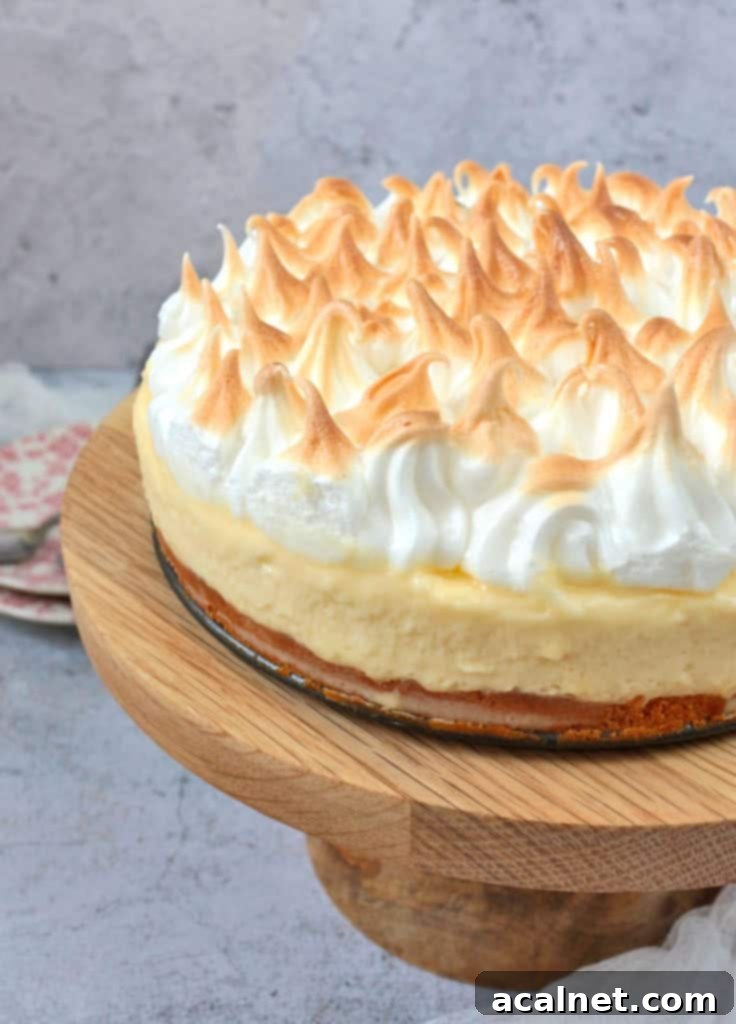
What is Sablé Breton? The Perfect Buttery Crust
A Sablé Breton is a renowned French butter cookie originating from the picturesque region of Brittany. These exquisite cookies are celebrated for their rich, buttery flavor and a uniquely tender, crumbly texture that melts in your mouth. Traditionally crafted with high-quality salted butter, they offer a depth of flavor that is truly unparalleled, making them much more than just a cookie.
Beyond their standalone deliciousness, Sablé Breton cookies are incredibly versatile and serve as an ideal base or crust for various pastries, cakes, and tarts. Their delicate crispness and inherent richness provide the perfect counterpoint to creamy fillings and tangy fruits. For our Lemon Meringue Mousse Cake, this crust adds a crucial textural element, providing a satisfying crunch that beautifully contrasts with the soft mousse and airy meringue.
Making a Sablé Breton crust is surprisingly quick and straightforward, requiring just a few staple ingredients to create a truly luxurious foundation for your dessert. To prepare this fabulous base, you will need:
- Fresh Egg Yolks for richness.
- Fine Confectioner’s Sugar (or powdered sugar) for sweetness and delicate texture.
- High-quality Salted Butter, softened to room temperature, which is the heart of the Sablé Breton’s flavor.
- All-Purpose (Plain) Flour for structure.
- A touch of Baking Powder to achieve that characteristic airy crumb.
The particular recipe used here for the Sablé Breton crust is a cherished adaptation from “French Patisserie,” a definitive guide published by the esteemed Ferrandi School of Culinary Art. If French baking holds a special place in your heart, consider this book your new essential companion. It’s a true treasure trove of authentic French pastry techniques and recipes!
For a comprehensive guide on making these delightful cookies, be sure to check out my full Sablé Breton Cookies recipe.
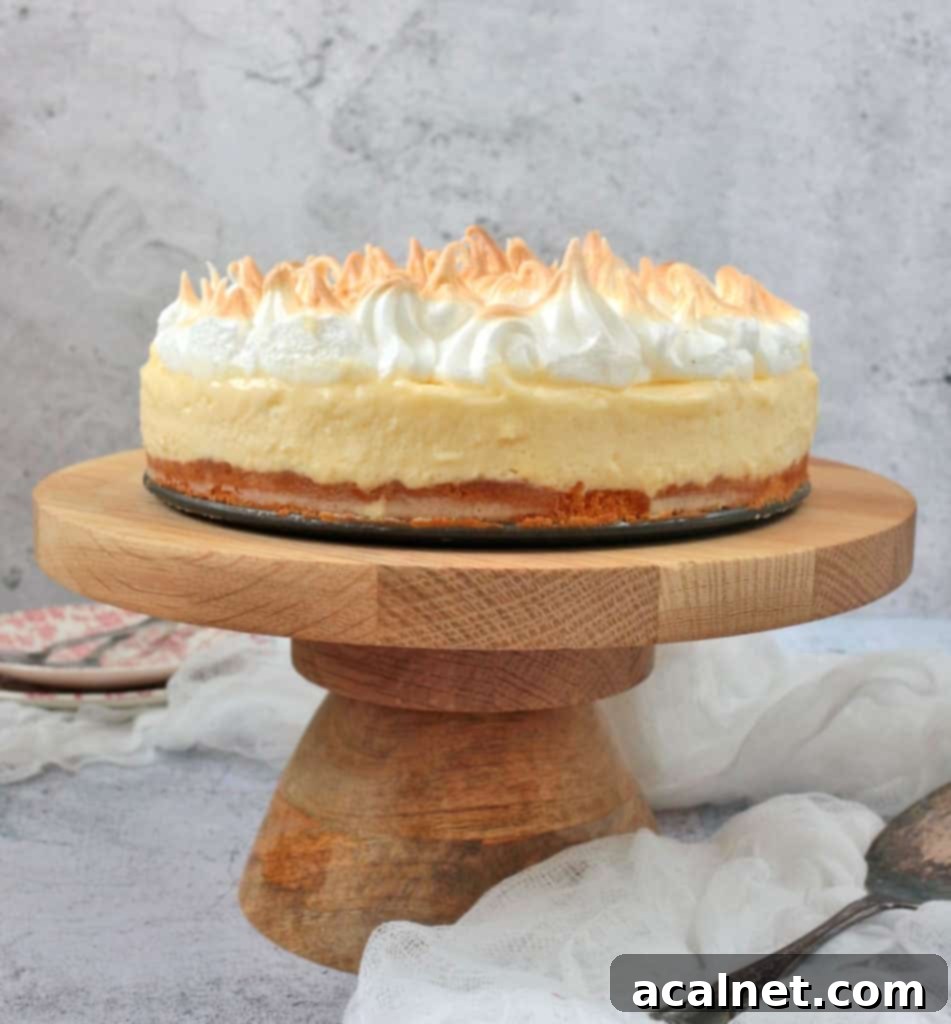
The Silky Heart: Tangy Lemon Mousse Cream
The Lemon Mousse is arguably the star of this celebratory cake. It’s not just any mousse; it’s a luscious Lemon Bavarian Cream – a delicate, airy, and intensely flavorful layer that provides the quintessential tangy counterpoint to the sweet meringue and buttery crust. Its creamy, light texture is utterly moorish, ensuring a refreshing experience with every spoonful.
So, what exactly is a Lemon Bavarian Cream (or Crème Bavaroise)? At its core, it’s a rich custard (in this case, a bright lemon curd) that is lightened with whipped cream and then stabilized with a gelling agent. Traditionally, gelatin is used, but for this recipe, we opt for Agar Agar Powder, a plant-based alternative that delivers a wonderfully smooth set. The beauty of Bavarian cream lies in its versatility; it can be flavored with a myriad of ingredients, from the decadent dark chocolate I used in my Chocolate Bavarian Cake to the fresh strawberries in my popular Strawberry Charlotte Cake!
Crafting this perfectly set Lemon Mousse involves a few key steps to ensure maximum flavor and ideal texture:
- Begin by carefully separating the Egg Yolks from the Whites. Reserve the Egg Whites for the meringue later – no waste here!
- In a small pot, gently heat the Lemon Juice until it just begins to boil. Meanwhile, vigorously whisk the Egg Yolks, Sugar, and Cornstarch until pale and smooth.
- Once the lemon juice is hot, gradually pour it over the egg yolk mixture while continuously whisking to temper the eggs. This prevents scrambling. Then, transfer the combined mixture back into the pot.
- Bring the mixture to a gentle boil over low heat, whisking constantly until it thickens into a rich lemon curd. At this point, incorporate the Agar Agar Powder, whisking for another minute to ensure it’s fully dissolved and activated. Remove from heat and allow it to cool. A quick note: if you’re using Gelatine, you would stir the re-hydrated gelatin into the lemon curd after it has cooled down slightly, not while it’s boiling.
- Finally, in a separate bowl, whip the Heavy, Thickened Cream until it forms soft to medium peaks – a lovely, thick Whipped Cream. Gently fold this whipped cream into your cooled lemon curd. The key here is to be delicate to maintain the airy texture.
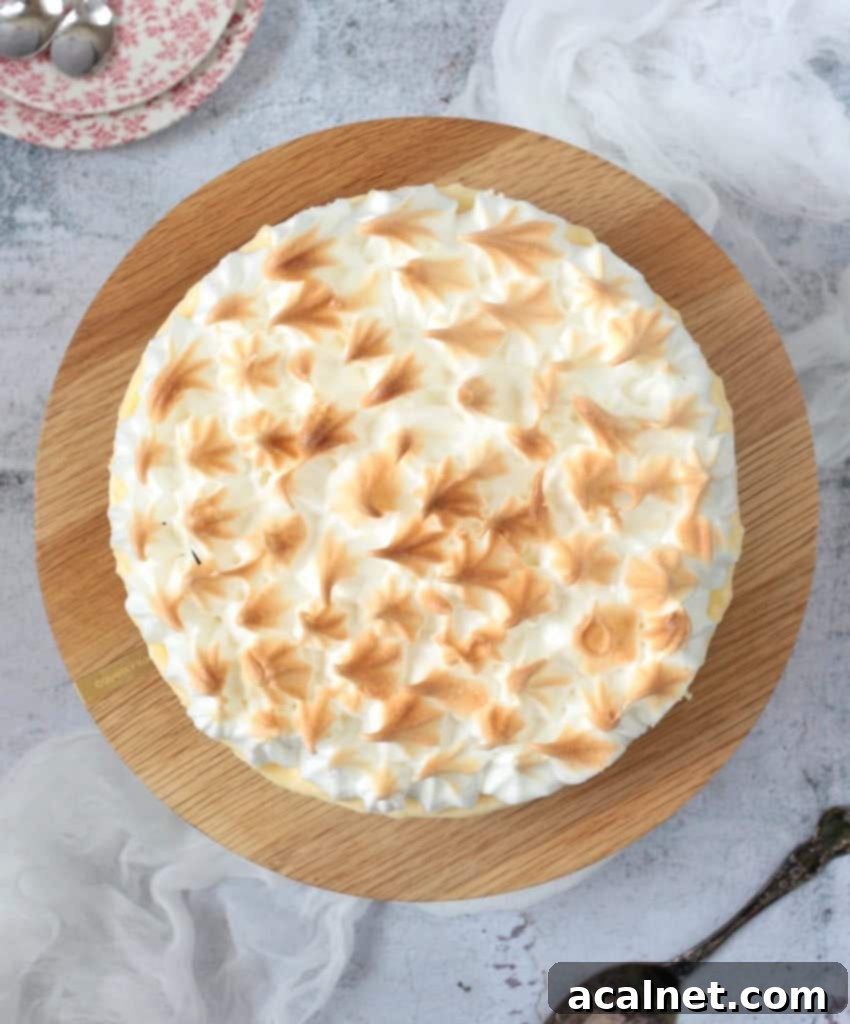
Crafting the Cloud: How to Make a Perfect French Meringue
The crowning glory of our Lemon Meringue Mousse Cake is the elegant, airy meringue. For this recipe, we utilize a “French Meringue,” which is often considered the most accessible and quickest meringue to prepare. Unlike its more involved counterparts, Italian or Swiss meringues, which demand heating the sugar syrup or the egg whites over a bain-marie, a French Meringue simply involves whipping egg whites into stiff, glossy peaks with the gradual addition of fine granulated sugar. This method yields a light, crisp, and beautifully delicate topping.
For those eager to understand the nuances of meringue making, an insightful article published on FineCooking.com offers a detailed comparison of French, Italian, and Swiss meringues.
Achieving that picture-perfect, stable meringue consistency is key. Here are my top tips to guide you:
- Gradual Whipping Speed: Resist the urge to go full-speed from the start! Begin whipping your egg whites on the slowest setting and gradually increase the speed as they become foamy. This slow, steady approach allows the protein structure in the egg whites to build more robustly, resulting in a significantly more stable, lighter, and fluffier meringue. While it takes a little more time, the superior texture is well worth the patience.
- Stabilize with Cream of Tartar: To enhance the stability of your meringue, incorporate a small amount of Cream of Tartar when you start whipping the egg whites. This acidic agent helps the egg proteins hold air better and prevents the meringue from collapsing. If you don’t have cream of tartar, a pinch of salt, a few drops of white vinegar, or even lemon juice can offer a similar stabilizing effect.
- Add Sugar Slowly and Precisely: The sugar should only be added once the egg whites have started to thicken and hold soft peaks. Drizzle the fine caster sugar in very slowly, a little at a time, while the mixer is running. Never dump it all in at once, as this can deflate your meringue. To ensure all the sugar has fully dissolved, rub a tiny bit of the meringue between your thumb and forefinger. If you can still feel any sugar grains, continue whipping until it’s completely smooth and glossy. Undissolved sugar can lead to a gritty texture and weeping meringue.
How to Brown Meringue Without a Blowtorch
The final, visually stunning element of this Lemon Meringue Mousse Cake is the gorgeous toasting of the meringue. This step often creates a wonderful “wow” moment, especially if you have a cooking blowtorch at hand to caramelize the peaks right at the table, dazzling your guests with a culinary flourish.
However, if a blowtorch isn’t part of your kitchen arsenal, absolutely do not worry! Achieving beautifully browned meringue is entirely possible using your oven’s grill (broiler) function. Here’s how to do it effectively:
- First, ensure your cake with the meringue topping is assembled and chilled.
- Set your oven’s grill or broiler to its highest setting.
- Carefully place the cake on a rack in the oven, positioned far enough from the heating element to prevent rapid burning but close enough to get adequate heat.
- Keep a vigilant eye on the meringue! Browning can happen very quickly, usually between 30 seconds to 2 minutes. The goal is to achieve lovely golden-brown peaks and valleys, adding a hint of caramelization and visual depth.
- Remove the cake as soon as the desired browning is achieved. Leaving it under the broiler for too long risks not only burning the meringue but also potentially melting the delicate lemon mousse underneath, altering its perfect texture.
This method ensures a beautifully finished cake, ready to impress, even without specialized equipment.
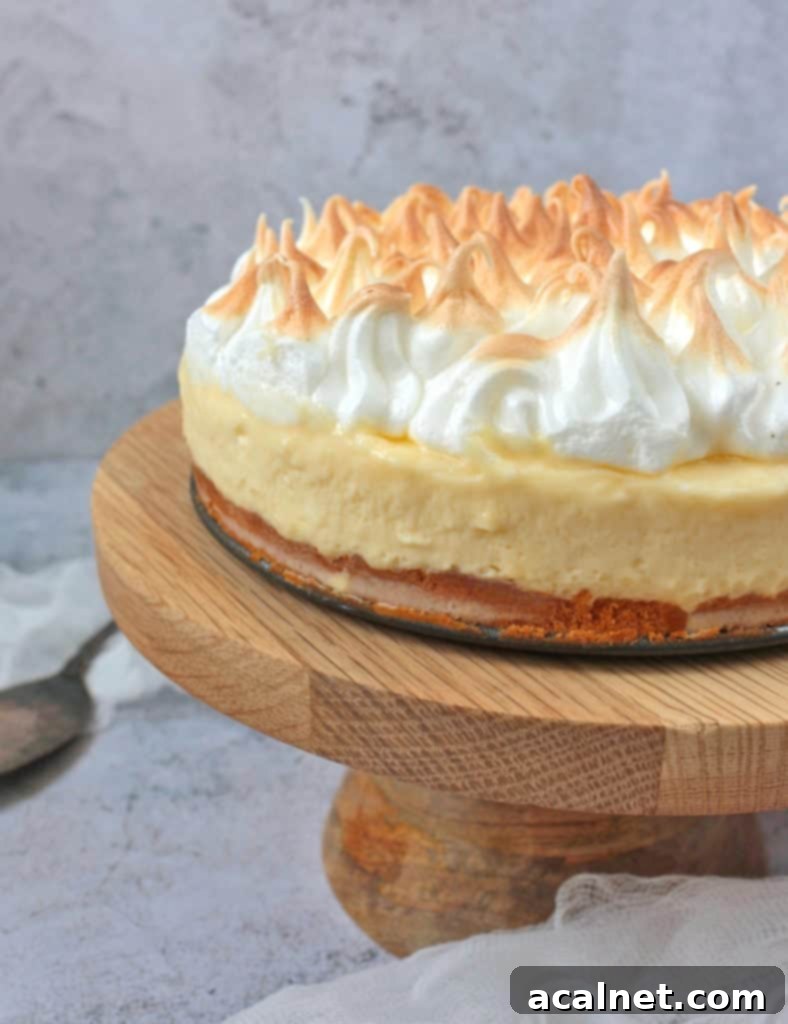
Storing Your Lemon Meringue Mousse Cake for Freshness
Proper storage is crucial for maintaining the exquisite taste and delicate texture of your Lemon Meringue Mousse Cake. The various components of this cake have different optimal storage conditions, so a little planning goes a long way.
You can store the Lemon Mousse Cake—that is, the Sablé Breton crust and the Lemon Bavarian Cream layers—in the refrigerator for up to 2 to 3 days. It’s best to keep these layers tightly covered to prevent them from absorbing fridge odors or drying out. For optimal freshness and presentation, the meringue layer should only be added shortly before serving. This is because the meringue is quite delicate and can start to “weep” or melt when it comes into prolonged contact with the acidic lemon cream, especially in a humid environment like a refrigerator.
Once the meringue has been added and toasted, the assembled cake should be enjoyed within 24 hours. While it can technically last a bit longer, the meringue will gradually lose its crispness and airy texture, becoming softer and stickier. For the ultimate experience, serve it the same day you add the meringue.
I strongly advise against freezing this cake. The Lemon Bavarian Cream, while delightful when fresh, does not freeze well. Freezing and thawing can significantly alter its creamy, smooth consistency, often resulting in a grainy or watery texture. Additionally, freezing would introduce excess moisture to the meringue, causing it to become soggy and melt upon thawing, completely compromising one of the cake’s most appealing features. For the best results, always serve this cake fresh.
More Delicious Celebration and Party Desserts
If you’re looking for other show-stopping desserts to elevate your next celebration or party, here are some fantastic ideas:
- Decadent Double Chocolate Bavarois Cake
- Aromatic Orange Glazed Spiced Honey Cake
- Light and Fluffy Lemon Ricotta Cake
- Elegant Strawberry Charlotte Cake
- Creamy Baked Lemon Ricotta Cheesecake
- Classic Lemon Curd Tart with Meringue
Made this recipe?
Let us know if you liked it by leaving a comment below, and tag us on Instagram @a.baking.journey with a photo of your creation!
Recipe

Lemon Mousse Cake with Toasted Meringue
Print Recipe
Ingredients
Sable Breton Crust
- 3 Egg Yolks
- 50 gr (1/3 cup) Confectioner Sugar, (or powdered sugar)
- 100 gr (6 1/2 tablespoons) Salted Butter, at room temperature
- 180 gr (1 cup + 3 tablespoons) Plain / All-Purpose Flour
- 1 teaspooon Baking Powder
Lemon Mousse (Lemon Bavarois Cream)
- 3 Egg Yolks
- 50 gr (1/4 cup) Caster Sugar
- 240 ml (1 cup) Lemon Juice
- 1 1/2 tablespoon Cornstarch
- 1 1/2 tablespoon Agar Agar Powder
- 300 ml ( 1 1/4 cup) Heavy / Thickened Cream , min 30% fat
Toasted Meringue
- 3 Egg Whites
- 1/2 teaspoon Cream of Tartare, optional
- 50 gr (1/4 cup) Caster Sugar
Instructions
Sable Breton Crust
- Seperate the Egg Yolks and Whites. Keep the Egg Whites for another recipe.
Whisk the Egg Yolks and Sugar until foamy. Add the cubed Butter at room temperature and stir until combined, using a silicone spatula to rub the butter into the batter (see note 1).
- Add the Flour and Baking Powder, and whisk until combined.
Gently press the pastry on the bottom of a round springform pan to get a uniform base. You may want to use the bottom of a cup to make sure the pastry is evenly flat.
- Place in the fridge while your oven is preheating on 180’C/350’F.
Bake for 10 to 15 minutes, or until the pastry starts to turn golden-brown.
Set aside to cool down completely before continuing the rest of the recipe.
Lemon Mousse (Lemon Bavarois Cream)
- Seperate the Egg Yolks and Whites. Place the Egg Whites in the fridge for later.
- Heat up the Lemon Juice in a small pot. In the meantime, whisk the Egg Yolks, Caster Sugar and Cornstarch.
As soon as the Lemon Juice starts to boil, remove from the heat and slowly pour over the egg yolks while continuously whisking. Stir to combine, then transfer the egg and lemon cream back in the pot.
- On low heat, whisk the liquid until it starts to thicken. Once it starts to boil, add the Agar Agar Powder, whisk for another minute and remove from the stove. Transfer into a clean bowl and set aside.
(See note 2 to use Gelatine Powder instead of Agar).
- In a seperate bowl, whip the Heavy Cream until you get a very stiff whipped cream. Gently fold in the Lemon Cream without over mixing it. Pour over the pre-baked Crust and place in the fridge to set for at least 2 to 3 hours.
Toasted Meringue
- Remove the Egg Whites from the fridge. Whip the Egg Whites with the Cream of Tartare until it starts to thicken. While continuously whipping, gradually add the Caster Sugar. Increase the speed of your mixer and whip until you get very stiff peaks.
- If you are not going to serve straight away, keep the meringue in the fridge until ready to serve.
Place the Meringue in a piping bag with your choice of nozzle (see note 3). Fully cover the cold Lemon Bavarois Cream with the Meringue.
- Place the cake under the grill/broiler of your oven, set on high. Leave for 30 seconds to 2 minutes, or until the meringue is toasted. Make sure to keep an eye on it to avoid burning it. Do not leave it for too long or the lemon mousse could start melting.
- Leave to cool for 5 to 10 minutes, then serve straight away.
Would you like to save this recipe?
We’ll email this post to you, so you can come back to it later!
Notes
- This is better done with a stand mixer
- If you prefer to use Gelatine Powder instead of Agar, follow the same steps up until the cream starts to thicken. Then, transfer into a clean bowl et leave to cool down. When cold, stir in the soaked Gelatine Powder (or gelatine sheets) then continue with the other steps.
- You can also simply drip the meringue over the lemon mousse and use a spatula to cover it.
Nutrition (per serving)
